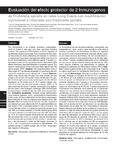
Please use this identifier to cite or link to this item:
http://ricaxcan.uaz.edu.mx/jspui/handle/20.500.11845/672| Title: | Evaluación del efecto protector de 2 inmunógenos de Trichinella spiralis en ratas Long Evans con modificación nutricional e infectado con Trichinella spiralis |
| Authors: | Maldonado Tapia, Claudia Reveles Hernández, Rosa Gabriela Saldivar Elías, Sergio Muñoz Escobedo, José Jesús Morales Vallarta, Mario Moreno García, María Alejandra |
| Issue Date: | 2007 |
| Publisher: | Sociedad Venezolana de Farmacología y de Farmacología Clínica y Terapéutica |
| Abstract: | La Trichinellosis es una zoonosis endémica, cosmopolita, sus huéspedes son, ratas, cerdo y otros mamíferos entre ellos el hombre, la presencia de Trichinellosis se debe a la ingestión de carne de cerdo insuficientemente cocinada, afecta a países con bajos recursos económicos. Se han caracterizado Inmunógenos, siendo el inmunodominante el de 45 kDa, efectivo contra T. spiralis, desafortunadamente no ha cristalizado en una vacuna. Se han descrito efectos de desnutrición (DN) sobre órganos linfáticos. Los mecanismos de defensa del huésped son alterados con DN proteico-calórico (DPC). Objetivo: Evaluar el efecto protector de 2 inmunógenos de T. spiralis en ratas Long Evans con modificación Nutricional e infectado con T. spiralis Metodología: 80 ratas Long Evans de 30 días de edad, divididas en 2 grupos: 40 Nut con 24 % de proteína y 40 DN con 12 % de proteína de los cuales se subdividieron en 8 sub grupos con tratamiento: a) 10 animales control b)10 animales infectados con T. spiralis, c) 10 animales inmunizados con antígeno soluble total (AST), d) 10 animales inmunizados con inmunógeno de 45 kDa de T. spiralis (esquema de inmunización una aplicación cada semana por 4 ocasiones), retados a la 1era semana de la culminación de inmunización, sacrificadas a la 6 sexta semana post-infección. Parámetros a evaluar: Determinación de la carga parasitaria mediante la Digestión Artificial (D/A), Determinación de las características morfológicas de la célula nodriza por la técnica de compresión de tejidos, detección de la respuesta inmune por WB. Resultados: Con la técnica de D/A, se obtuvieron en los diferentes tratamientos, de las ratas Nut, DN, Inmunizadas e Infectadas. Mostró diferencia significativa en la cantidad de LI que se presentaron en 30gr de músculo estriado. los grupos controles de ratas Nut y DN sin infección, ausencia de LI, y en los grupos de ratas Nut Infectadas, se recolectaron 200 μl de LI, para el grupo de DN infectado se recolecto 400 μl de LI, en el grupo de Nut inmunizadas con AST e infectadas, se recolectó 10 μl de LI, mientras que en las tratadas con DN se recuperaron 100μl de LI. En el tratamiento de ratas Nut inmunizadas con antígeno de 45 kDa más infección de T. spiralis, no presento LI, mientras que en las tratadas con DN se recuperaron 10 μl de LI, con modificaciones morfológicas. Conclusión: la carga parasitaria en animales tratados con inmunógeno de 45 kDa nutridos fue negativa. |
| Description: | The Trichinellosis is an endemic zoonotics, cosmopolitan, which is hosted in rats, pigs, and other mammals including humans. The presence of Trichinellosis is due to ingestion of insufficiently cooked swine meat. Poor countries with low medical resources are mainly affected by the disease. A numbered of immunogen have been characterized 45kDa was found to be the immunodominant most effective against T. spiralis, unfortunately a vaccine has not yet been found. Malnutrition (DN) effects have been described/detected in lymphatic organs. The immune mechanisms of the host have been altered with DN caloric-proteic (DPC). Objetive: The protective effect of two 2 immunogen of T. spiralis was evaluated in Long Evans rats with nutritional modifications and infected with T. spiralis. Methods: Eighty Long Evans rats (30 days old) were divided into two groups a 40 nut with 24% protein and a 40 DN with 12% protein of which eight groups were divided again into the different treatments: a) 10 control rats, b) 10 T. spiralis infected rats, c)10 immunized rats with total soluble antigens (AST), d) 10 immunized with 45 kDa of T. spiralis immunogen (one application per week in four dosages), challenged after the first week of immunization, sacrificed after the sixth week of post-infection. Evaluation parameters: Parasite charge determination using artificial digestion, (D/A), morphological characteristics of the nurse cell were determined by the tissue compression tests. Detention to immune response was determined by WB. Results: Different treatments to treat the nut, DN, immunized and infected rats were obtained by D/A. A significant difference was shown in the Ll quantities present in 30 g of muscle. The nut and DN rats control, in Ll absence, and in the groups of nut rats, 200 ul of Ll were collected, in the DN infected group 400ul of Ll were collected, in the Nut immunized with AST and infected, 10 ul of Ll were collected. Meanwhile the rats treated with DN recovered 100 ul of Ll. In a similar manner, the treatment for the Nut rats with vaccinated 45 kDa and the T. spiralis infection; it did not present Ll. while the DN treated recovered 10 ul of Ll, with morphological modifications. Conclussion: The parasite charge in treated animals with 45 kDa immunogen was negative in Nut group. |
| URI: | http://localhost/xmlui/handle/20.500.11845/672 https://doi.org/10.48779/yr11-m825 |
| ISSN: | 0798-0264 |
| Other Identifiers: | info:eu-repo/semantics/publishedVersion |
| Appears in Collections: | *Documentos Académicos*-- UA Ciencias Biológicas |
This item is licensed under a Creative Commons License

